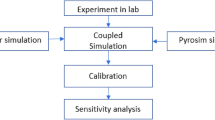Abstract
In the safety design of marine systems, the matter of human life in the event of a marine fire must be considered. It may be difficult to establish a safe evacuation system because a characteristic behavioral pattern based on human factors is elusive. This study consists of three analyses on (1) the state of smoke diffusion, calculated by the use of a two-layer zone model, (2) evacuation movements, simulated by a group behavioral model, and considering the occurrence of panic and the smoke spreading phase, and (3) the risk index for safety assessment using the results of smoke diffusion and escape movements. This risk index can be used for comparisons between various safety systems, and its validity is confirmed by an evacuation model of common spaces on a typical cruise ship.
Similar content being viewed by others
References
SR Tieszen (2001) ArticleTitleOn the fluid mechanics of fires Annu Rev Fluid Mech 33 67–92 Occurrence Handle10.1146/annurev.fluid.33.1.67
DD Gray A Giorgini (1976) ArticleTitleThe validity of the boussinesq approximation for liquids and gases Int J Heat Mass Transfer 19 545–551 Occurrence Handle10.1016/0017-9310(76)90168-X
N Fukuchi C Hu (2004) ArticleTitleA pseudofield model approach to simulate compartment-fire phenomena for marine fire safety design J Mar Sci Technol 8 177–184 Occurrence Handle10.1007/s00773-003-0171-5
G Erlebachar MY Hussaini CG Speziale TA Zang (1992) ArticleTitleToward the large-eddy simulation of compressible turbulent flows J Fluid Mech 238 155–1851
Weaver S (2000) A comparison of data reduction techniques for zone model validation. Fire Eng Res Rep 2000/12, USA, pp 3–18
Tanaka T (2000) Necessity of design methodology in the framework of a performance-based fire safety design system. In: 15th Meeting of the UJNR Panel on Fire Research and Safety, NSTIR 6588, vol 1, pp 435–440
Takahashi K, Tanaka (1988) An evacuation model for use in fire safety design of buildings. In: Proceeding of the 2nd International Symposium on Fire Safety Science
J Rasmussen (1982) ArticleTitleHuman errors: a taxonomy for describing human malfunction in industrial installations J Occup Accid 4 311–335 Occurrence Handle10.1016/0376-6349(82)90041-4
Ikeda K (1986) Intelligence process in an emergency (in Japanese). Publishing Association of Tokyo University, pp 115–149
N Fukuchi et al. (1999) ArticleTitleAn analysis of evacuation behavior by using the walking model with psychological intelligence process in an emergency (in Japanese) J Soc Nav Archit Jpn 184 545–558
Kugihara N (1995) Panic experiment-social psychology (in Japanese). Nakanishiya Press
M Nagane (1987) ArticleTitleThe stress index based on an examination of psychological stress using the MFF test (in Japanese) Jpn J Psychol 157 383–386
Jones WW, Quinteire JG (1984) Prediction of corridor smoke filling by zone models. Combus Sci Technol 835:239–243
Katsuhara M, et al (1996) Simulations and demonstrations of human escape on board. RINA Conference on Escape, Evacuation and Rescue
WW Jones JG Quinteire (1984) ArticleTitlePrediction of corridor smoke filling by zone models Combus Sci Technol 835 239–243
Saito H (1977) The report on action and psychological response of building exodus (in Japanese). In: Proceeding of the Society of Architects of Japan (Chugoku District)
Ministry of Transport of Japan, Transport Policy Bureau (1997) A transport white paper, Part 2. The trend of public transportation (in Japanese). pp 712–714
Author information
Authors and Affiliations
Corresponding author
About this article
Cite this article
Fukuchi, N., Imamura, T. Risk assessment for fire safety considering characteristic evacuees and smoke movement in marine fires. J Mar Sci Technol 10, 147–157 (2005). https://doi.org/10.1007/s00773-005-0193-2
Received:
Accepted:
Issue Date:
DOI: https://doi.org/10.1007/s00773-005-0193-2




